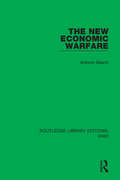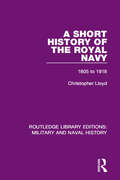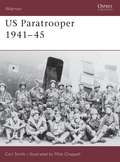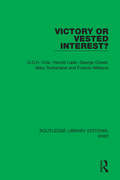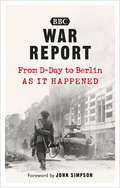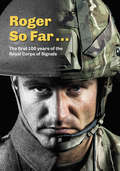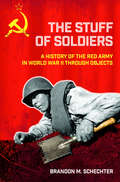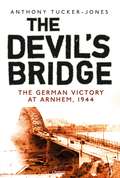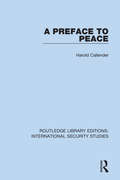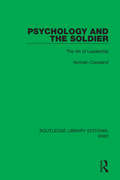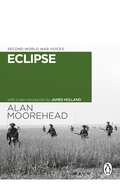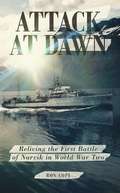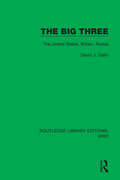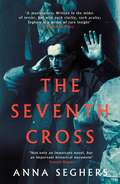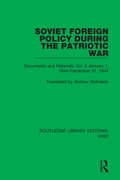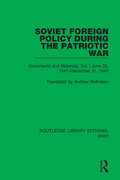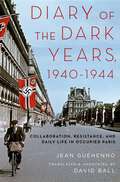- Table View
- List View
The New Economic Warfare (Routledge Library Editions: WW2 #21)
by Antonín BaschThis book, first published in 1942, examines the economic necessities, defensive and offensive, basic and strategic, involved in waging war. Written with total global war raging, it analyses the unprecedented demands placed on the economic system of a nation, and looks at the great shifts of productive effort and limits on consumption that were needed.
The New Economic Warfare (Routledge Library Editions: WW2 #21)
by Antonín BaschThis book, first published in 1942, examines the economic necessities, defensive and offensive, basic and strategic, involved in waging war. Written with total global war raging, it analyses the unprecedented demands placed on the economic system of a nation, and looks at the great shifts of productive effort and limits on consumption that were needed.
A Short History of the Royal Navy: 1805-1918 (Routledge Library Editions: Military and Naval History)
by Christopher LloydNaval histories often stop short at the death of Nelson. This book succinctly fills the gap by covering the golden age of British sea power – the period which saw the defeat of Napoleon, the American War, the expansion of the empire, the introduction of the steamship and the defeat of the first German menace. Not only a galaxy of heroic episodes, this book also highlights the relationship between the Navy in war and peace to the nation as a whole.
A Short History of the Royal Navy: 1805-1918 (Routledge Library Editions: Military and Naval History)
by Christopher LloydNaval histories often stop short at the death of Nelson. This book succinctly fills the gap by covering the golden age of British sea power – the period which saw the defeat of Napoleon, the American War, the expansion of the empire, the introduction of the steamship and the defeat of the first German menace. Not only a galaxy of heroic episodes, this book also highlights the relationship between the Navy in war and peace to the nation as a whole.
US Paratrooper 1941–45 (Warrior #26)
by Carl Smith Mike ChappellIn Sicily, Normandy, and in the frozen hills of the Ardennes, America's airborne warriors proved themselves some of the toughest and most determined soldiers of World War 2. What made these soldiers so special? How were they recruited, how did they learn to jump and fight? What special tactics and equipment did they use? This title looks at what it was like to be one of the United States' airborne elite, through the experiences of the soldiers themselves. It is the story of the men who invariably led the way; the soldiers who flew to battle and walked home.
Victory or Vested Interest? (Routledge Library Editions: WW2 #38)
by George Orwell Harold Laski G.D.H. Cole Mary Sutherland Francis WilliamsThis book, first published in 1942, covers the whole field of wartime life and organization. Is the private ownership and control of industry holding up production? Are the burdens of war being shared equally by the whole community? How can individual liberty be reconciled with maximum efficiency? Are women taking their rightful share in the national effort? Does our literature and art reflect the spirit of an aroused and determined people? Have we a message which will win the oppressed peoples of Europe to our side? These questions are frankly discussed and positive suggestions are made.
Victory or Vested Interest? (Routledge Library Editions: WW2 #38)
by George Orwell Harold Laski G.D.H. Cole Mary Sutherland Francis WilliamsThis book, first published in 1942, covers the whole field of wartime life and organization. Is the private ownership and control of industry holding up production? Are the burdens of war being shared equally by the whole community? How can individual liberty be reconciled with maximum efficiency? Are women taking their rightful share in the national effort? Does our literature and art reflect the spirit of an aroused and determined people? Have we a message which will win the oppressed peoples of Europe to our side? These questions are frankly discussed and positive suggestions are made.
War Report: From D-Day to Berlin, as it happened
by John Simpson Desmond HawkinsWAR REPORT, the landmark BBC radio program, first broadcast after the nine o-clock news on D-Day, 6 June 1944 and provided an almost-daily chronicle to millions of listeners of the final year of World War II. A team BBC reporters, including Chester Wilmot, Frank Gillard, Wynford Vaughan Thomas and Richard Dimbleby, trained and were embedded with British troops, a first in war reporting: they landed side by side with soldiers, in gliders, by parachute, in assault-craft, talking into portable recording machines to ‘tell it as it was’. For eleven months these reporters were in the vanguard, filing over 1,500 dispatches covering the desperate exchanges on the D-Day beaches, the battle for Caen, the advance through Normandy, the liberation of Paris and, finally, the German surrender in 1945. 70 years after the invasion of Normandy, the dispatches of War Report collected here provide a unique and visceral account of Allied efforts to liberate Europe and end the war. It is history direct from the front line, filled with all the horror and excitement of eleven months that changed the world.
Roger So Far ...: The first 100 years of the Royal Corps of Signals
by Royal Corps of SignalsSince 1920, the Royal Corps of Signals has provided the British Army’s central nervous system, enabling orders to be delivered and information to be exchanged, principally at the higher levels of command. It has been crucial in supporting the vast majority of military land-based operations after the First World War. Its importance is growing because conducting successful operations is becoming increasingly reliant upon being able to operate in a congested and contested electronic battlespace. ROGER SO FAR does not aim to tell the full story of the Royal Corps of Signals, since much of the Corps’ work now and in the past is secret. Instead the book is a celebration of the Corps’ achievements and the ability of its soldiers to use innovation and improvisation to deliver results beyond all reasonable expectations. As well as acting as an historical record, including reminiscences covering several aspects of life within the Corps during its first 100 years, it seeks to stir memories and to inform those who are serving, or have served in the Corps, as well as to inform those who have not served and those who may be thinking of doing so.
The Stuff of Soldiers: A History of the Red Army in World War II through Objects (Battlegrounds: Cornell Studies in Military History)
by Brandon M. SchechterThe Stuff of Soldiers uses everyday objects to tell the story of the Great Patriotic War as never before. Brandon Schechter attends to a diverse array of things—from spoons to tanks—to show how a wide array of citizens became soldiers, and how the provisioning of material goods separated soldiers from civilians.Through a fascinating examination of leaflets, proclamations, newspapers, manuals, letters to and from the front, diaries, and interviews, The Stuff of Soldiers reveals how the use of everyday items made it possible to wage war. The dazzling range of documents showcases ethnic diversity, women's particular problems at the front, and vivid descriptions of violence and looting.Each chapter features a series of related objects: weapons, uniforms, rations, and even the knick-knacks in a soldier's rucksack. These objects narrate the experience of people at war, illuminating the changes taking place in Soviet society over the course of the most destructive conflict in recorded history. Schechter argues that spoons, shovels, belts, and watches held as much meaning to the waging of war as guns and tanks. In The Stuff of Soldiers, he describes the transformative potential of material things to create a modern culture, citizen, and soldier during World War II.
The Devil's Bridge: The German Victory at Arnhem, 1944
by Anthony Tucker-JonesIn the late summer of 1944, SS-Obergruppenführer Wilhelm 'Willi' Bittrich found himself in the Netherlands surveying his II SS Panzer Corps, which was in a poor state having narrowly escaped the defeat in Normandy. He was completely unaware that his command lay directly in the path of a major Allied thrust: the 17 September 1944 launch of the largest airborne and glider operation in the history of warfare. Codenamed Operation Market Garden, it was intended to outflank the German West Wall and 'bounce' the Rhine at Arnhem, from where the Allies could strike into the Ruhr, Nazi Germany's industrial heartland. Such a move could have ended the war. However, Market Garden and the battle for Arnhem were a disaster for the Allies. Put together in little over a week and lacking in flexibility, the operation became an all-or-nothing race against time. The plan to link the airborne divisions by pushing an armoured division up a sixty-five-mile corridor was optimistic at best, and the British drop zones were not only too far from Arnhem Bridge, but also directly above two recuperating SS Panzer divisions. This new book explores the operation from the perspective of the Germans as renowned historian Anthony Tucker-Jones examines how they were able to mobilise so swiftly and effectively in spite of depleted troops and limited intelligence.
A Preface to Peace (Routledge Library Editions: International Security Studies #15)
by Harold CallenderThis book, first published in 1944, assesses the prospects of peace following the Allied victory in the Second World War. It examines the tasks that victory would impose on the victors; the development during the war of US policies, military and political; the errors that caused the war; and the viewpoints and needs of the Allied powers. Concluding that the future peace could be only achieved through the power and influence of the United States, it argues that the process of uniting the Allies in peace would need greater statesmanship than united them in war against a common enemy.
A Preface to Peace (Routledge Library Editions: International Security Studies #15)
by Harold CallenderThis book, first published in 1944, assesses the prospects of peace following the Allied victory in the Second World War. It examines the tasks that victory would impose on the victors; the development during the war of US policies, military and political; the errors that caused the war; and the viewpoints and needs of the Allied powers. Concluding that the future peace could be only achieved through the power and influence of the United States, it argues that the process of uniting the Allies in peace would need greater statesmanship than united them in war against a common enemy.
Psychology and the Soldier: The Art of Leadership (Routledge Library Editions: WW2 #25)
by Norman CopelandThis book, first published in 1944, stresses the point that there is no shortcut to successful wartime leadership, and pays a close analysis to the attributes that contribute to being a sound leader of soldiers. Written in the middle of the Second World War, this book gives us valuable insights into the values and training of the British Army in the second half of the war.
Psychology and the Soldier: The Art of Leadership (Routledge Library Editions: WW2 #25)
by Norman CopelandThis book, first published in 1944, stresses the point that there is no shortcut to successful wartime leadership, and pays a close analysis to the attributes that contribute to being a sound leader of soldiers. Written in the middle of the Second World War, this book gives us valuable insights into the values and training of the British Army in the second half of the war.
Eclipse (Second World War Voices)
by Alan MooreheadPart of the SECOND WORLD WAR VOICES series in partnership with the podcast We Have Ways of Making You Talk, presented by comedian Al Murray and bestselling historian James Holland.With a new introduction by James HollandEclipse was the code name given by the Allies to the occupation of Germany. Moorehead's book describes his experiences in Sicily and southern Italy in 1943, which culminated in the capture of Rome. He tells the electrifying story of D-Day, the liberation of Paris, and the Allied advance through northern France and Belgium, the crossing of the Rhine.The author reconstructs, in terrifying detail, the collapse of Germany, the wholesale destruction, mass surrenders, and the unimaginable horrors of the concentration camps.
Attack at Dawn: Reliving the Battle of Narvik in World War II
by Ron CopeOn March 1, 1940, Adolf Hitler ordered the invasion of Norway. Having swept across Europe at a terrifying pace, the Nazi assault on Scandinavia was designed to secure the valuable source of iron ore being delivered by rail from Sweden to the Norwegian port of Narvik. To complete the task, Hitler sent ten large, modern destroyers, with 220 Alpine Troops on each. Five smaller British H Class destroyers were sent up the fjord in retaliation by the Allied forces, with little knowledge of what to expect. On April 10, the first battle of Narvik began. Royal Naval Captain, Bernard Warburton-Lee, led his flotilla at midnight into the fjord. They had to navigate the four hour passage undetected, under darkness and in driving snow storms. The harbour - eerily silent on their arrival - quickly erupted into a torpedo attack. Back into the fjord, the destroyers Hardy, Hunter, Hotspur, Havock and Hostile were confronted by five German destroyers, coming from both the front and rear. This resulted in a ferocious sea battle with the loss of Hardy and Hunter and damage to the enemy ships. Those crew members who managed to abandon ship and swim ashore, under bombardment from the Germans, had to endure a ten mile march and pray for safe passage back to Britain in order to survive. Author Ron Cope delivers a comprehensive and gripping account of the Narvik battle, juxtaposing the myriad strategic difficulties encountered by the British Navy, with the vivid and insightful personal accounts of the brave survivors involved, most of whom were under the age of twenty-three. Including first-hand testimony from Cope's own father Cyril, a then twenty-one year old Torpedoman, and documents shared for the first time by the family of Captain Warburton-Lee, Cope presents an arresting account of this crucial British naval victory, as told by the sailors who were there. "Meticulously researched, Attack at Dawn relates the vivid real-life experiences of the British sailors who took part in the extraordinarily bold attack by five British destroyers against superior German forces at Narvik... and the desperate running battle that ensued as they tried to make their escape". John Warburton-Lee, grandson of Captain Bernard Warburton-Lee. V.C.
The Big Three: The United States, Britain, Russia (Routledge Library Editions: WW2 #2)
by David J. DallinThis book, first published in 1946, analyses the state of the world at the close of the Second World War. Global power was passing from Britain to the United States and the Soviet Union, with the US being involved in every part of the world, Russia dominant in eastern Europe and the world looked a very uncertain place. This survey of the main three powers examines their changing conditions and foreign policies.
The Big Three: The United States, Britain, Russia (Routledge Library Editions: WW2 #2)
by David J. DallinThis book, first published in 1946, analyses the state of the world at the close of the Second World War. Global power was passing from Britain to the United States and the Soviet Union, with the US being involved in every part of the world, Russia dominant in eastern Europe and the world looked a very uncertain place. This survey of the main three powers examines their changing conditions and foreign policies.
The Seventh Cross (Virago Modern Classics #779)
by Anna Seghers'It was [Seghers] who taught my generation and anyone who had an ear to listen after that not-to-be-forgotten war to distinguish right from wrong. The Seventh Cross shaped me; it sharpened my vision' GUNTER GRASS'A masterpiece. Written in the midst of terror, but with such clarity, such acuity; Seghers is a writer of rare insight' RACHEL SEIFFERT author of A Boy in WinterSeven prisoners escape from Westhofen concentration camp. Seven crosses are erected in the grounds and the commandant vows to capture the fugitives within a week. Six men are caught quickly, but George Heisler slips through his pursuers' fingers. It becomes a matter of pride to track him down, at whatever cost.Who can George trust? Who will betray him? The years of fear have changed those he knew best: his brother is now an SS officer; his lover turns him away. Hunted, injured and desperate, time is running out for George, and whoever is caught aiding in his escape will pay with their life.The Seventh Cross is one of the most powerful and influential novels of the twentieth century, a tense thriller that helped to alert the world to the grim realities of Nazi Germany.'The Seventh Cross is not only an important novel, but an important historical document. This new, unabridged translation is a genuine publishing event' JOSEPH KANON, author of The Good German and Leaving Berlin'A fascinating insight into life in pre-war Nazi Germany just as the horrors of the Nazi regime were beginning to unfold. This is an important novel, as much for its picture of German society as for its insight into the psyche of ordinary people confronting their personal fears and mixed loyalties' SIMON MAWER, author of The Glass RoomIn The Seventh Cross, Seghers's aim was to write, 'A tale that makes it possible to get to know the many layers of fascist Germany through the fortunes of a single man.' She had four copies of the manuscript: one was destroyed in an air raid; a friend lost the second copy while fleeing the Nazis; another was found by the Gestapo; only the fourth copy survived, which, fortunately, she sent to her publisher in America just before she escaped Nazi-occupied France. Published in 1942, The Seventh Cross was an immediate bestseller and was the basis for an MGM film starring Spencer Tracy in 1944. It has been translated into more than 40 languages.Margot Bettauer Dembo's expert new translation makes the complete text of this great political novel available in English for the first time.
Soviet Foreign Policy During the Patriotic War: Documents and Materials. Vol. II January 1, 1944–December 31, 1944 (Routledge Library Editions: WW2 #31)
by Andrew RothsteinThis book, first published in 1946, collects documents illustrating the foreign policy of the Soviet Union during the Second World War. They show how the fighting alliance of the USSR, Britain and the USA came into being and grew stronger, how relations were restored with other anti-Nazi countries, and how diplomatic relations were extended between the USSR and hitherto un-connected countries. The collection of three parts of translated documents: statements and speeches made by Stalin; documents, treaties, agreements; appendices including press statements and telegrams.
Soviet Foreign Policy During the Patriotic War: Documents and Materials. Vol. I June 22, 1941–December 31, 1943 (Routledge Library Editions: WW2 #30)
by Andrew RothsteinThis book, first published in 1946, collects documents illustrating the foreign policy of the Soviet Union during the Second World War. They show how the fighting alliance of the USSR, Britain and the USA came into being and grew stronger, how relations were restored with other anti-Nazi countries, and how diplomatic relations were extended between the USSR and hitherto un-connected countries. The collection of three parts of translated documents: statements and speeches made by Stalin; documents, treaties, agreements; appendices including press statements and telegrams.
Soviet Foreign Policy During the Patriotic War: Documents and Materials. Vol. I June 22, 1941–December 31, 1943 (Routledge Library Editions: WW2 #30)
by Andrew RothsteinThis book, first published in 1946, collects documents illustrating the foreign policy of the Soviet Union during the Second World War. They show how the fighting alliance of the USSR, Britain and the USA came into being and grew stronger, how relations were restored with other anti-Nazi countries, and how diplomatic relations were extended between the USSR and hitherto un-connected countries. The collection of three parts of translated documents: statements and speeches made by Stalin; documents, treaties, agreements; appendices including press statements and telegrams.
Soviet Foreign Policy During the Patriotic War: Documents and Materials. Vol. II January 1, 1944–December 31, 1944 (Routledge Library Editions: WW2 #31)
by Andrew RothsteinThis book, first published in 1946, collects documents illustrating the foreign policy of the Soviet Union during the Second World War. They show how the fighting alliance of the USSR, Britain and the USA came into being and grew stronger, how relations were restored with other anti-Nazi countries, and how diplomatic relations were extended between the USSR and hitherto un-connected countries. The collection of three parts of translated documents: statements and speeches made by Stalin; documents, treaties, agreements; appendices including press statements and telegrams.
Diary of the Dark Years, 1940-1944: Collaboration, Resistance, and Daily Life in Occupied Paris
by Jean GuéhennoWinner of the French-American Foundation Translation Prize for Nonfiction Jean Guéhenno's Diary of the Dark Years, 1940-1945 is the most oft-quoted piece of testimony on life in occupied France. A sharply observed record of day-to-day life under Nazi rule in Paris and a bitter commentary on literary life in those years, it has also been called "a remarkable essay on courage and cowardice" (Caroline Moorehead, Wall Street Journal). Here, David Ball provides not only the first English-translation of this important historical document, but also the first ever annotated, corrected edition. Guéhenno was a well-known political and cultural critic, left-wing but not communist, and uncompromisingly anti-fascist. Unlike most French writers during the Occupation, he refused to pen a word for a publishing industry under Nazi control. He expressed his intellectual, moral, and emotional resistance in this diary: his shame at the Vichy government's collaboration with Nazi Germany, his contempt for its falsely patriotic reactionary ideology, his outrage at its anti-Semitism and its vilification of the Republic it had abolished, his horror at its increasingly savage repression and his disgust with his fellow intellectuals who kept on blithely writing about art and culture as if the Occupation did not exist - not to mention those who praised their new masters in prose and poetry. Also a teacher of French literature, he constantly observed the young people he taught, sometimes saddened by their conformism but always passionately trying to inspire them with the values of the French cultural tradition he loved. Guéhenno's diary often includes his own reflections on the great texts he is teaching, instilling them with special meaning in the context of the Occupation. Complete with meticulous notes and a biographical index, Ball's edition of Guéhenno's epic diary offers readers a deeper understanding not only of the diarist's cultural allusions, but also of the dramatic, historic events through which he lived.
